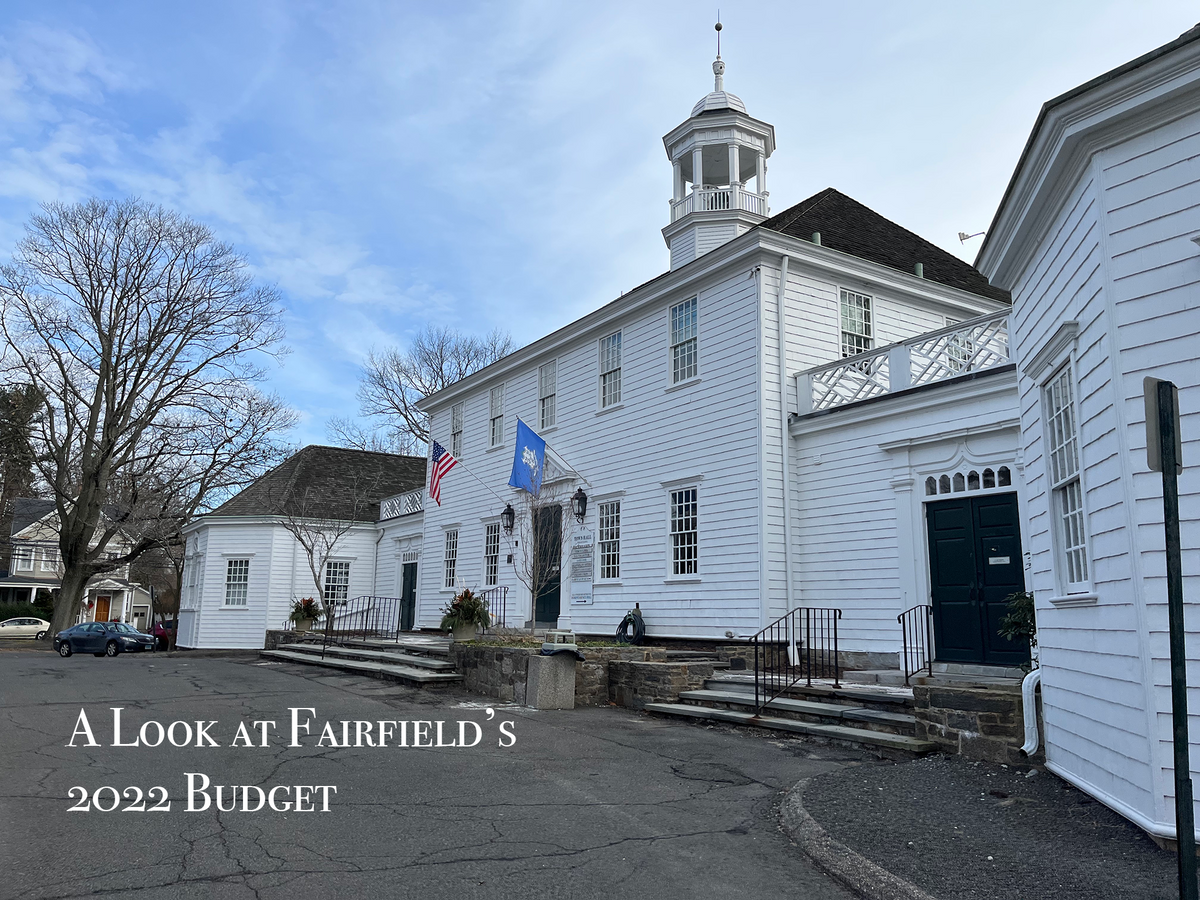A Look at Fairfield's Budget for 2022-23
We examined each community's budget for 2022-23 in southwest Connecticut. Here is a breakdown of Fairfield's.

For 2022-23, Fairfield’s operating budget, which covers the day-to-day operations of the town of more than 61,000 people, is $345.1 million. This budget is an increase of about 3.8% compared to last year's budget of $332.3 million.
The majority of Fairfield’s budget comes from local taxes. More than $319 million will be collected in local taxes. The town plans to receive about $7.1 million in funding from state and federal government sources, such as from the state as a part of the education cost sharing formula. More than $18.8 million is projected in other revenues, such as revenue generated by town departments and interest.
Let’s take a look at how the budget breaks down by section in this town.
Education
About 59% of Fairfield’s budget, or $203.6 million goes toward the school district.
In general, the education budget covers many areas, including: salaries and benefits for teachers, administrators, and staff; curriculum materials; support services in schools; special programs, such as career pathway programs for high schoolers; and athletic and extracurricular materials.
In Fairfield, some education highlights include:
- Providing additional special education services to students who need them
- Replacing aging technology equipment
- Creating a middle school block schedule with additional resources to address proficiency gaps at that level
Public Safety
About 10.3% of Fairfield’s budget, or $35.6 million goes toward the town’s public safety efforts, which includes fire, police, and joint emergency communications.
Generally, the public safety budget covers many areas, including: salaries for police officers, firefighters, administrators, and support staff; equipment, such as body cameras; training programs; emergency communications; and emergency preparedness resources.
In Fairfield, some public safety highlights include:
- Continuing to work on the Emergency Communications Center, which currently is a joint dispatch center with Westport and could include a third town in the future
- Adding two police officers
Public Works
About 7.2% of Fairfield’s budget, or $24.9 million supports the public works budget for the town. Public works covers many areas including parks and recreation, engineering, operations, road maintenance, and more.
The budget for public works generally includes funding for efforts in those departments, such as: road and sidewalk maintenance; engineering and design work; resources to maintain parks and recreation facilities, as well as infrastructure support; salaries for public works administration and staff; wastewater and stormwater management; and support for trash and recycling.
In Fairfield, some public works highlights include:
- Increasing funding to paving program to catch up on needed roadway improvements
- Providing engineering support to multiple projects in town
- Adding new programming for residents at recreational facilities in town
Community and Human Services
About 2.5% of Fairfield’s budget, or $8.7 million goes toward community and human services in the town. Everything from health departments to libraries, mental health services to youth and senior needs falls into community and human services. This category also includes funding that cities give to local nonprofits and agencies to provide some of these services.
In Fairfield, some of the highlights for community and human services include:
- Making the director of social services a full-time position to address the need to help support low-income residents and provide mental health services.
- Making the senior center director a full-time position to help address the growing needs of seniors
Economic and Community Development
About 0.3% of Fairfield budget, or just over $1 million is for economic and community development-related efforts, which include planning, zoning, and land use departments.
Generally, this budget includes the work of those departments, such as: application reviews; city-wide plans; zoning and building code enforcement; updates to the zoning regulations; business support; art and history commissions; tourism activities; and salaries for economic and community development staff.
In Fairfield, some of the economic and community development highlights include:
- Working to identify and pursue opportunities, such as grants, as suggested in the new affordable housing plan
- Supporting and working to redevelop the Fairfield Metro and former Exide Battery sites.
- Continuing to modernize operations with an online permitting system
General Government
About 3.9% of Fairfield’s budget, or just under $13.6 million supports general government needs in the town, which includes the office of the first selectperson, finance, town clerk, IT, human resources, legal, customer service, and support staff for elected officials, such as the RTM.
The general government budget includes the work and people in those departments, such as salaries for employees in those areas; customer support initiatives and programs, such as “click and report” applications; communications to the public; records keeping; licenses, such as marriage and dog licenses; IT support; tax collection; budgets; and agendas and meeting materials.
In Fairfield, some of the general government highlights include:
- Continuing to modernize operations
- Working on a transition in the Human Resources department, with the department head retiring and a cut in funding to the department in the approved budget.
Employee Benefits and Pensions
About 9% of Fairfield’s budget, or $31.2 million goes toward employee benefits and pensions.
Debt Service
About 7% of Fairfield’s budget, or just under $24.2 million, goes toward debt service.
Other
About 0.7% or $2.4 million goes toward other costs in the town.
If you’d like more information, view the full town budget.
How we did this: We reviewed each community’s published budget and found the budgeted expenses by department and put them into the categories listed above. Please note: Not every municipality categorizes its budgets the same way. For example, some organize Parks and Recreation funds under Public Works, while others separate it. For consistency, we tried to move and place the similar departments into the same buckets.



